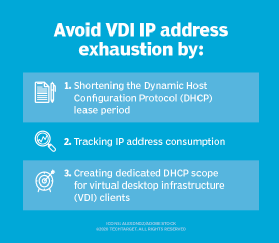
Orlando Florin Rosu - Fotolia
3 tips to prevent VDI IP address exhaustion before it happens
For those turning to VDI to support remote workers due to the COVID-19 influx, it's best to get ahead of IP address problems before people return to the office.
Virtual desktops have taken center stage for many organizations, now that a majority of people are presently being forced to work from home due to the COVID-19 pandemic. One side-effect of accommodating this sudden influx of remote workers is a lack of IP addresses, also known as IP address exhaustion or depletion.
The coronavirus has many organizations scrambling to scale up their work-from-home IT infrastructure. One way they achieved this was to greatly expand the deployment of virtual desktops, sometimes even by repurposing or redirecting hyper-converged infrastructure hardware.
Whether or not IP address depletion is much of an issue right now -- after you have scaled up your remote work infrastructure to meet the needs of your new cadre of remote workers -- it almost certainly will be when most employees eventually head back to the office. When that happens, it is unlikely organizations will abandon their new investment in virtual desktops after all the time and money spent standing up the virtual desktop infrastructure (VDI). Instead, employees will probably continue to use their office computers as thin clients and work from virtual desktops.
This can be problematic, however, as each worker will now consume two IP addresses. The employee's physical device uses an IP address, while the virtual desktop takes another.
Compounding the problem
Employees who access virtual desktops from personal devices while in the office only compound the IP address exhaustion problem. After all, each of these devices -- and there could be a lot of them -- will also consume an IP address.
It is also worth noting that Dynamic Host Configuration Protocol (DHCP) servers lease addresses to devices for specific lengths of time. Therefore, even if a device connects to the network for five minutes, it may continue to consume an IP address for days until the lease eventually expires. Lease periods vary, but many DHCP servers use a default of seven days.
How to avoid running out of IP addresses
IT professionals can implement several best practices to avoid running out of IP addresses.
First, shorten the DHCP lease period. That way, transient devices won't consume IP addresses for days, or even weeks.

Second, use the Windows Server Internet Protocol Address Management feature -- or a comparable third-party tool -- to track IP address consumption. That way, you will be able to better anticipate shortages.
Finally, create a dedicated DHCP scope for your virtual desktops. This prevents virtual desktops from contributing to the exhaustion of your IP address pools.
At some point the danger will subside and employees will head back to the office. When that happens, the best practices presented here can help you be prepared. So, don't run out of IP addresses due to the likelihood of your new and/or expanded VDI remaining in place and users accessing their virtual devices from multiple corporate and personal devices while at the office.
Hyper-converged VDI
Virtual desktops are some of the best ways to support a remote user base, and hyper-converged infrastructure platforms are ideally suited to act as virtual desktop hosts. Ease of use, flexibility and scalability are among the many factors that suit hyper-convergence to the needs of VDI.
If you have old or spare hyper-converged systems laying around -- or you can rapidly offload workloads from those currently in use to other types of systems or the cloud -- hyper-convergence could be the answer to having to quickly support larger numbers of remote users. Exactly the predicament many organizations found themselves in during the coronavirus pandemic.
Even so, IT professionals must consider two important factors when turning to hyper-convergence to host virtual desktops. First, they must be careful to avoid creating any single points of failure. Second, they need to make sure virtual desktops do not overtax available hardware to the point where performance slows to a crawl and other workloads, especially mission-critical ones, become affected.








